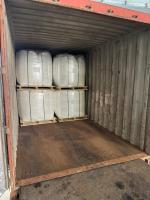Our Products
Polyacrylamide / largest mud chemical manufacturer for drilling in China
Anionic polyacrylamide (APAM) is one of the most widely used polymer additives in drilling fluids due to its unique molecular structure, high molecular weight, and strong ability to modify the rheology of water-based mud systems. When applied as a mud chemical, anionic polyacrylamide plays multiple functions—ranging from viscosity enhancement and fluid-loss control to cuttings encapsulation, suspension improvement, friction reduction, and wellbore stability. Its multifunctional behavior allows drilling engineers to optimize mud performance under varying geological conditions, including shale formations, sandstone reservoirs, deep wells, and high-temperature environments. Because the drilling mud system must continuously carry cuttings, cool the bit, control pressure, stabilize the borehole, and minimize formation damage, the incorporation of anionic polyacrylamide into drilling fluids provides a cost-effective and technically efficient method to achieve these operational goals.
One of the primary functions of anionic polyacrylamide in mud chemicals is viscosity building. APAM molecules have extremely long polymer chains that dramatically increase viscosity when hydrated in fresh water or low-salinity drilling fluids. This increased viscosity improves the carrying capacity of the mud, ensuring that drilled cuttings are efficiently transported to the surface. Without proper viscosity, cuttings may settle in the annulus, causing pack-offs, stuck pipe, poor hole cleaning, and excessive torque and drag. APAM’s shear-thinning behavior is also particularly valuable—it provides high viscosity at low shear rates (in the annulus) for suspension, while reducing viscosity at high shear rates (through the bit nozzles), lowering pump pressure and energy consumption.
Another key function of anionic polyacrylamide as a mud chemical is its role as a fluid-loss control agent. APAM molecules can bridge and plug microfractures and pore spaces in the formation, creating a low-permeability filter cake that prevents excessive filtrate infiltration. Reducing filtrate loss is essential for preventing formation damage, controlling wellbore hydration, reducing differential sticking, and maintaining hydrostatic balance. In shale formations, reduced filtrate invasion helps control swelling and dispersion of reactive clays, thus improving wellbore stability. APAM is often used in combination with PAC, CMC, or starch-based additives to create a synergistic effect that delivers superior filtration control.
In addition, anionic polyacrylamide functions as an effective shale suppressant and cuttings stabilizer. Although APAM is not a classic shale inhibitor like KCl or polyamine, its long chains adsorb onto the surface of clay particles, forming a protective polymer layer that reduces clay swelling, dispersion, and hydration. By binding to negatively charged clay surfaces, APAM helps maintain cuttings integrity and reduces fines generation. This prevents the formation of high-viscosity slurries caused by clay dispersion and promotes more predictable mud rheology. It is especially beneficial when drilling through gumbo shale, bentonite-rich formations, or reactive clay zones that tend to collapse when exposed to water.
Anionic polyacrylamide also plays a significant function as a thinner and flocculant in solids control. In drilling operations, solids content steadily increases as the well deepens. Excessive fine solids cause increased plastic viscosity, reduced drilling rate, and formation damage. When added in controlled concentrations, APAM acts as a flocculant that aggregates fine clay particles and suspended solids, causing them to settle more efficiently in the mud pits or get removed by the shale shaker and centrifuges. By promoting solids removal, APAM maintains optimal rheology, reduces dilution costs, and improves the overall life of the drilling mud system.
Another valuable function of APAM in mud chemistry is its ability to act as a drag reducer and friction reducer. Due to the high molecular weight and long-chain structure, anionic polyacrylamide reduces turbulence in the fluid flow, especially in high-velocity circulation systems. This leads to lower pump pressure, reduced energy consumption, and higher operational efficiency. In horizontal and extended-reach wells, friction reduction significantly enhances hole cleaning and decreases the risk of stuck pipe.
APAM also plays a role in enhancing wellbore stability by consolidating loose formation particles and preventing instability caused by mechanical erosion. The polymeric film formed by APAM on the borehole walls helps seal microcracks and strengthens the formation against fluid invasion and mechanical breakdown. This stabilization is crucial in unconsolidated sandstone, gravel beds, and highly permeable formations.
In addition to its mechanical and rheological functions, anionic polyacrylamide acts as a lubricant enhancer, especially when blended with other lubricants or glycol-based additives. The polymer chains reduce friction between the drill string and wellbore walls, improving tool movement and reducing torque. This is particularly important in deviated wells, long laterals, and wells with complex geometries.
Because of its excellent performance and cost-effectiveness, APAM is widely used in water-based drilling fluids, polymer drilling systems, bentonite-based muds, and low-solids or non-dispersed mud systems. Its compatibility with various additives, such as lignite, PAC, and synthetic polymers, allows engineers to tailor mud systems based on formation characteristics.
In summary, the primary functions of anionic polyacrylamide used as a mud chemical include viscosity building, fluid-loss control, solids flocculation, shale stabilization, friction reduction, borehole stabilization, and overall rheology optimization. Its versatility makes it an essential additive for drilling operations across onshore, offshore, deepwater, and shale gas applications.




975_small.jpg)
311_small.jpg)